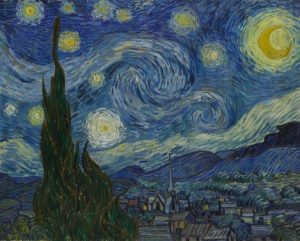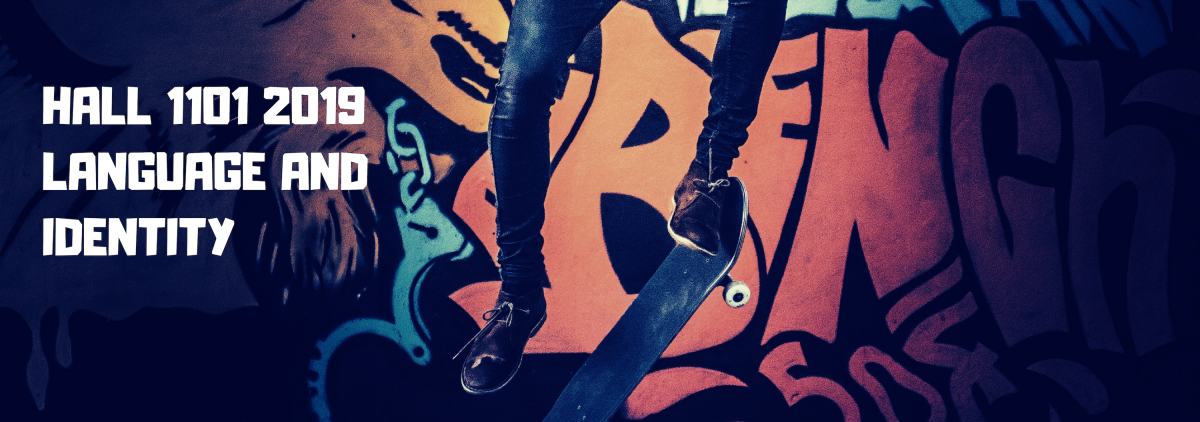Britney Lilly
Dr. Hall
1101
4.13.19
Scholastic Art Magazine
A Starry Night and its Tortured Soul

Vincent van Gogh wasn’t just the man who decided to chop his left ear off because he wanted to give it to someone he loved (or so they say). Vincent van Gogh was a man of many faces, all of which turned into a life of unexpected twists, turns, and emotional turmoil.
Though Vincent van Gogh was thought of as a tortured soul, the life he lived and the roles he played created the artist we revere today. Just like many of people nowadays, Vincent van Gogh clearly struggled with mental disabilities along with some physical ones throughout his life. He has been commonly believed to eat his yellow paint in the hopes that its color would brighten his demeanor. Though in reality while he did eat his paints it was found by Dr. Peyron to have been in attempts of suicide through poisoning “The medical notes of Dr Peyron, Vincent’s physician, revealed that Vincent wanted to poison himself by eating paint and drinking turpentine. That’s probably why he wasn’t allowed into his studio while he was suffering from his attacks”(VanGoghmuseum).Vincent van Gogh also had the habit of consuming absinthe while falling into a fit of emotions that lasted for the remainder of his life.
He later admitted himself to an asylum after one of his fits caused him to chase his roommate painter Paul Gauguin around with a razor in hand. That evening ended in the severing of Vincent van Gogh’s left ear (which he handed to the brothel owner in which he frequented) though no one really knows if it was by him or Gauguins’. When Vincent van Gogh arrived back home, this is when he shot himself in the stomach in a wheat field where later his brother Theo had found him bleeding. Vincent van Gogh died a few days later from internal damage and inability to remove the bullet, and his brother Theo followed after six months, leaving many to think Theo unable to live his life without his brother when in fact he really died from syphilis.
In his death, Van Goghs’ fame rose quickly, causing many doctors to attempt in diagnosing this plagued artist. He is commonly thought to have suffered from psychosis, bipolar disorder, schizophrenia, epilepsy, borderline personality disorder, severe depression, and paralyzing anxiety. No matter what they tried to diagnose him with, Van Gogh was a man with much sorrow, who tried to work through his pain with his paintbrushes. And because of this he created beautiful and emotionally driven paintings that can be seen and felt throughout the art world.
It was 1889 when Vincent Van Gogh admitted himself into Saint-Rémy asylum after having a nervous breakdown, there he found he could “paint en plein air” (French for outdoors), it is here that he pained one of his most famous masterpieces. The scene of “The Starry Night” came entirely from Van Gogh’s imagination, none of the scenery actually matches the area that surrounds Saint-Paul or the view seen from his window. As a man who religiously paints what he sees, it’s a remarkable break from Van Gogh’s normal work.
Really look at his brush strokes. From the sky and how they swirl, to each dab of color moving with the clouds around the stars and the moon. The cypress tree that bends with each curve of the branches. The whole effect is graceful and dreamlike it’s like each stroke is creating a dance only his mind understands. The hills lazily spiral down into the village below. In a striking difference, the town is painted with rigid lines that break up the fluid like the flow of the brush strokes. There are fewer trees through out that soften the harshness of the town merging nature into the roughness of buildings. The contrast in styles plays on the dreams versus reality or natural and unnatural. Nature could even be attributed to the divine in this work. While in the asylum Vincent van Gogh wrote to his brother, “I feel a tremendous need for religion, so I go outside at night to paint that stars.” (Theartpostblog). In his search for self discovery and healing, he found that the sky, the nature, the starry nights satisfied his desire for infinity. (Theartpostblog).
It reminded me when I placed myself into an institution, like Vincent van Gogh I placed myself in willingly after a mental breakdown. There I met a nurse who would paint replications of many famous artists’ paintings, with Vincent van Gogh painting being one of them. This was where I found my love for his artwork. Watching her as she would paint with practiced strokes and concentrated face of what she saw Vincent van Goghs’ painting to be through her mind’s interpretation. That along with the telling of his life’s tale I soon saw how I could relate to such a beautifully broken mind. Through my own turmoil just as he had his, he inspired me. I believe everything can be beautiful if you just try to see it through another’s eyes.
Many people have seen a picture of “The Starry Night” either in a museum or on the internet and felt the power of his brush strokes created in their soul. I myself have gotten lost in this painting many times. The connection that is felt inside myself when I view “The Starry Night” is indescribable, I become at ease. It is as though the world around me has melted away where the colors start becoming one. In my personal episodes of depression, anxiety, mental breakdowns, this painting has brought me to places of solace. The calming blues, swirling whites mixed with yellow, the speckles of stars, and the sleepy town below is a place I wish I could be. A constant place of steadiness created from a mind that was in wild disarray .
Life is moving so quickly that people forget to stop and appreciate the small things yet people always seem to ask, but why? Why should I care? For me people like that have a tendency to close themselves off when a new world is offered to them. It’s as if those types of people are afraid to step out of the confinement of their personal bubble. “The Starry Night” shows that even in the darkness there’s an underlying beauty in the things that are around us if we know how to look. Everything that is created is made with emotion and care. You don’t have to necessarily like something to understand the emotion behind it. That is what art is, the emotion that brought that image, sound or story to life.
When people have their mindset in the place of pain and misery, there is not much that we can do for that person in terms of reliving their sorrow. When dealing with manic depression, if it is not handled properly, what that person has been through to that point is normal to them, even though their judgment is seen as askew. If someone is going to commit suicide such as Vincent van Gogh, then they have readily convinced themselves that they are no longer needed in this world. Letting go is the easy part, it’s finding subnational reason to hold on that is hard.
Works Cited
o www.vangoghmuseum.nl/en/125-questions/questions-and-answers/question-63-of-125?fbclid=IwAR2oZa0GI0vXi0T3BtyocuqvgZ9bDKHFYQyLCRxlm_MvV4VHQziDK6slPUk&v=1.
o “The Starry Night by Van Gogh: What It Represents.” The Art Post Blog | Art and Artists Italian Blog, 14 Mar. 2019, www.theartpostblog.com/en/the-starry-night-by-van-gogh-what-it-represents/.



